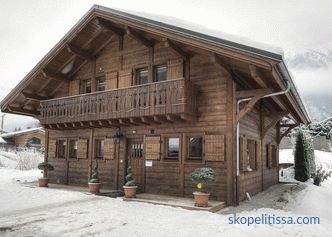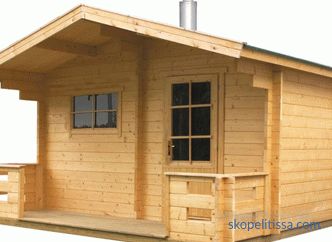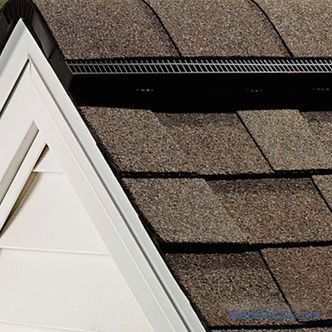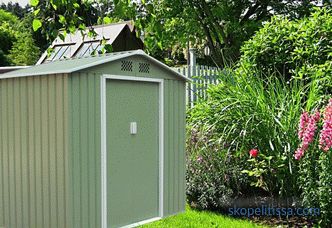Building a house is a complex and expensive process. Purchase of materials, payment for installation works and other expenses. But modern technologies for the construction of private houses create opportunities for less expensive construction of a warm, reliable and beautiful building, without losing the quality of the work done.
There are a lot of construction methods, so among them it is necessary to find a suitable method for all parameters. After all, as well as the old and new technologies in the construction of private houses have their positive and negative sides.
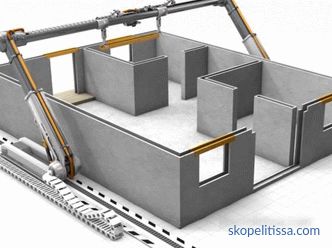
Using new technologies in the construction of private houses
The innovative materials that have been created recently, but already firmly occupying their niche include:
-
glued laminated timber;
-
foam concrete blocks;
-
aerated concrete blocks;
-
CIP panels.
But even with the use of standard technologies for the construction of private houses, new methods of finishing, insulation, pouring and so on can be applied.
Technology TISE
TISE - the technology of individual construction and the environment, also known as "folk" or "moving formwork", was developed in Russia. The main advantages that influence the choice of TISE are simplicity and cost-effectiveness when building a house.
Features and principle of technology
The foundation of a house built using TISE is a filler pile or pile-foundation foundation, the peculiarity of which is the expanding sole of concrete piles. Expansion of the sole is done by a special drill, which is sold with a set of equipment for work.
Walls are erected from lightweight hollow blocks, which are formed on the spot in special forms into which concrete is poured. When the mixture solidifies, the module is removed and rearranged to the place of pouring the next block.

Advantages and disadvantages
Pros of construction technology private houses:
-
low cost of construction - the house is being built practically from scrap materials without using heavy machinery;
-
construction can be conducted in any conditions , even if it is not possible to connect to the power grid;
-
the minimum time construction;
-
low labor costs ;
-
allows you to sum communications in a simple way.
Disadvantages of technology:
-
is not suitable for use in muddy or water-flooded areas , so as piles due to increased loads, they simply break down or sink;
-
difficult installation in rocky grounds that are very difficult to drill;
-
The grillage and piles must be reliably protected from moisture. - blind areas (waterproof coatings that are located along the perimeter of the building) must be large in size.
Frame houses
It is often used in construction, as the method is very simple to implement. In addition, the frame allows you to create a variety of options for building arrangement.
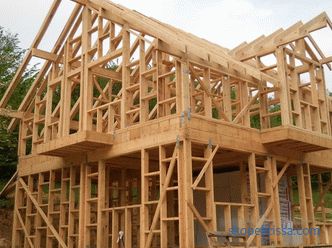
What is special about the construction of
According to this technology for the construction of private houses, the frame installed on a pile or concrete foundation - depending on the type of soil and weight of the house. The frame itself is made of different materials - most often it is a tree, but light steel thin-walled structures (LSTC technology) are also used. The choice of material is made depending on the conditions in which the house will be built and financial possibilities. The metal frame is more expensive than wood, although if the wood is processed correctly, then there will most likely be no tangible difference in quality and strength. The main thing is to use a high-quality timber, which can serve for a long time, preserving its properties.
When using a frame house, there are several options for filling walls :
-
OSB that become wall panels, filled with any heat-insulating material;
-
prefabricated shield CIP panels , which already have additional protection from moisture, wind and insulation.
On our website you can find contacts of construction companies that offer the service of designing country houses. Directly to communicate with representatives, you can visit the exhibition of houses "Low-rise Country".
Advantages and disadvantages
Pros of technology:
-
low cost ;
-
high speed of construction (a team of six people can build a house in just a month);
-
communication systems are easily laid inside walls;
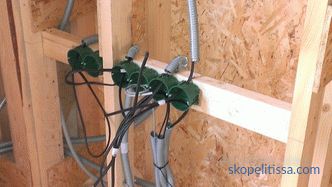
-
simplicity installation;
-
construction is possible in any season ;
-
use lifting equipment ;
-
equipping lightweight foundation , which allows to reduce its cost;
-
the plates from which the house is made will not "sit" , that is, after a while they will not decrease or increase in size.
Disadvantages of technology:
-
Short life - overhaul is required every 20-30 years.
-
High fire hazard is a general lack of wooden houses, although statistics say that fires in them occur no more often than in stone ones. In any case, all materials used are treated with flame retardants, and non-combustible insulation is recommended for insulation.
-
In time, the tree may start to rot , especially in those places where a large amount of moisture is concentrated. To eliminate this drawback, materials are treated with antiseptics;
-
Low insulation when compared with houses made of concrete or brick. During construction, emphasis is placed on noise-attenuating materials that can correct the deficiency;
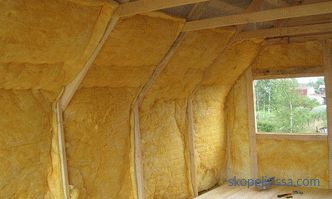
-
The environmental properties of buildings will depend on the materials used. If the economy goes beyond the reasonable and low-quality synthetic materials are used, then the walls can become a source of harmful fumes; and are eliminated at the design stage of the house.
It might be interesting! In the article on the following link, read about home technology using German technology.
3d-panels
New technologies in construction have not bypassed the possibility of 3D printing. 3D panels are an advanced build of frame-panel houses. The panels are monolithic slabs with reinforced mesh on each side. They are connected with metal rods passing through.
Features
The main feature of 3D panels is their production method. Construction waste mixed with cement is loaded into a 3D printer. Upon completion of the printing process, the output is a finished wall. This process is not only fast in production, but also cheap. Therefore, technology is used to create low-rise buildings.
Printed walls are hollow. The space is filled using foam concrete, so the walls are equipped with reinforced mesh on all sides.
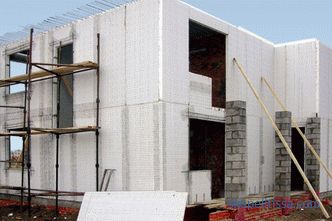
Construction of a frame house from 3D panels Pros and cons
Pros of using this construction technology private houses:
-
low cost when buying standard panels;
-
low weight constructions;
-
the possibility of building at any time of the year ;
-
minimum damage for the landscape ;
-
low heat loss .
Disadvantages of technology:
-
cost increases if you order panels according to individual drawings;
-
in insulation can get pests ;
-
the need to create an advanced ventilation ;
-
insulation ;
-
with strong impacts (for example, an earthquake) the house may collapse, which is not the case frame house built on Canadian technology.
It can be interesting! In the article on the following link read about the materials and technology of a warm blind area around the house.
Fixed formwork
A well-known and often used technology for the construction of private houses.
Features
The main feature of this house building technology is the simple construction procedure.
A permanent formwork is made of blocks or panels that must be placed throughout the foundation at a certain distance to form a pier. Between these walls is placed reinforcement, and then poured concrete.
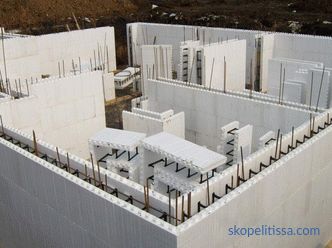
The outer walls of the formwork become concrete after the solidification of the concrete Pros and cons
Pros of technology:
-
building a house costs much cheaper ;
-
the most difficult to build is only filling the foundation ;
-
when choosing an appropriate filler for wall formwork , no additional thermal insulation is required.
Obviously about the technology of fixed formwork, see the video:
It might be interesting! In the article on the following link read about the glazing of the porch of the house in the cottage or in the country.
Houses from vulture panels
Houses that are built from vulture panels require the selection of quality materials. Under such panels refers to the shield material, consisting of two chipboard. Between them there is heat and waterproofing. The main advantage of this type of panels is installation on site.
In addition, there are other advantages:
-
operational construction;
-
panels are not heavy, which will make a lightweight foundation .
But, despite the fact that the panels are very light, they are pretty durable. The finished house will be not only warm, but also strong. After the impact of the hurricane or snowfall, the vulture panels will not be damaged.
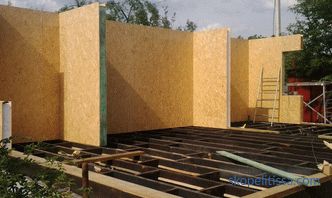
A house made of CIP panels is assembled as a designer Velox
Velox is a new house building technology that is used in the construction of residential buildings. Construction consists in the use of permanent formwork, which is made of chip-and-cement type slabs. The thickness can be different, the plates are connected with cement mortar, to which liquid glass is added. Such a solution has water-repellent properties, which is an undoubted advantage for building. The outer plate has additional insulation and a seal made from expanded polystyrene.
Pros of technology:
-
low weight and thickness;
-
there is no additional insulation;
-
construction efficiency;
-
durability and structural strength.

The walls of the house are erected using the Velox technology Clearly about the Velox technology, see the following Video:
It can be interesting! In the article on the following link read about how to build a basement of a house with a basement.
Conclusion
Thanks to the large selection of technologies that are used in building houses, you can always choose the right one. The main thing is to use quality materials.
But we should not forget that new technologies in the construction of private houses imply maximum reasonable savings, primarily on the foundation, due to the lower weight of the buildings. This allows you to use more economical lightweight foundations, but at the same time the calculation of the loads should be as accurate as possible, which means that this work should be done by specialists.
-
